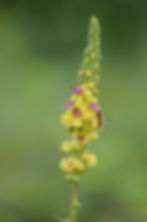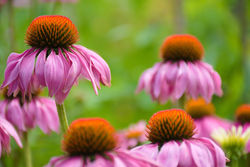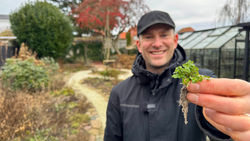34 edible flowers that are safe for children to eat
- Lars Wildes
- Feb 8, 2023
- 9 min read
Updated: Feb 23, 2023
As a kindergarten teacher (and dad), I see children putting all kinds of things in their mouths, from dirt to flowers. They explore the world through their senses by smelling, touching, and tasting things in the playground. For this reason, our school focuses on having safe and non-toxic plants in our playground, such as flowers in raised beds and safe, edible flowers and plants that kids can eat.
When it comes to eating flowers and plants, make sure all flowers are well washed before eating, and never eat flowers from florists, nurseries, or supermarkets without washing them. It’s best to use flowers from your own garden so you know exactly what’s on them.
Are you looking for safe flowers and plants for your garden? Here’s my list of the best 34 edible flowers and plants.
1. Cornflower | Centaurea cyanus

Even the name of this flower sounds delicious. Cornflowers are annual or biennial plants with beautiful blue or pink flowers. They are a popular ornamental plant and also have edible petals. They’re native to Europe but are now found throughout the world.
Height: 30-90 cm (12-36 inches)
Sun exposure: Full sun to partial shade
Soil type: Well-drained soil
Blooms: Summer to early autumn
2. Dwarf Marigold | Tagetes pumila

Dwarf marigolds are compact, bushy plants with yellow or orange flowers. They are commonly used as bedding plants or as borders. They’re also used in traditional medicine in some countries and are safe to eat.
Height: 15-20 cm (6-8 inches)
Sun exposure: Full sun
Soil type: Well-drained soil
Blooms: Summer to early autumn
3. Pot Marigold | Calendula officinalis

Pot marigolds are annual plants dripping with bright yellow or orange flowers. They are often used as a medicinal herb and in cooking.
Height: 30-60 cm (12-24 inches)
Sun exposure: Full sun to partial shade
Soil type: Well-drained soil
Blooms: Summer to early autumn
4. Wild Pansy | Viola tricolor

Wild pansies are annual or biennial plants covered with small, brightly colored flowers in shades of blue, purple, yellow, and white. They’re often used as ornamental plants and are loved for their medicinal properties, too.
Height: 10-20 cm (4-8 inches)
Sun exposure: Partial shade to full sun
Soil type: Well-drained soil
Blooms: Spring to autumn
5. Forget-Me-Not | Myosotis

Forget-me-nots are herbaceous perennials loved for their pink or white flowers. They’re popular as garden ornamental plants and are also used in traditional medicine.
Height: 20-40 cm (8-16 inches)
Sun exposure: Full sun to partial shade
Soil type: Well-drained soil
Blooms: Spring to summer
6. Nasturtium | Tropaeolum majus

Nasturtiums (Indian Cress) are annual climbers covered in brightly colored flowers in shades of red, yellow, and orange. They’re totally edible and are commonly used in salads and as a garnish.
Height: 60-150 cm (24-59 inches)
Sun exposure: Full sun
Soil type: Well-drained soil
Blooms: Summer to autumn
7. Hollyhock | Alcea

Hollyhocks are tall, upright perennials that produce large spikes of flowers in shades of pink, red, yellow, and white. They look great planted in the back of your flower borders and they’re even used in traditional medicine.
Height: 150-300 cm (59-118 inches)
Sun exposure: Full sun to partial shade
Soil type: Well-drained soil
Blooms: Summer to early autumn
8. Pinks | Dianthus

Dianthus is a genus of flowering plants that includes popular garden flowers such as carnations and pinks. They have fragrant, brightly colored flowers that bloom on top of thin stems. The foliage is usually blue-green and evergreen. Some species of Dianthus are edible, with a slightly sweet and clove-like flavor.
Height: 20-60 cm (8-24 inches)
Sun exposure: Full sun to partial shade
Soil type: Well-drained, fertile soil
Blooms: Spring to Summer
9. Bee Balm | Monarda

Monarda, also known as bee balm or wild bergamot, is a hardy herb with showy spikes of pink, lavender, or purple flowers. The leaves are fragrant and often used in teas. The plants are extremely attractive to bees, butterflies, and hummingbirds. Monarda is edible and has a slightly minty flavor.
Height: 60-90 cm (24-36 inches)
Sun exposure: Full sun to partial shade
Soil type: Moist, well-drained soil
Blooms: Summer to Fall
10. Hosta

Hosta is a popular shade-loving perennial loved because of its lush foliage in shades of green, yellow, or blue. The plants produce spikes of bell-shaped flowers in shades of lavender or white. Hosta leaves are edible and have a slightly bitter flavor.
Height: 20-90 cm (8-36 inches)
Sun exposure: Partial to full shade
Soil type: Moist, well-drained soil
Blooms: Summer
11. English Lavender | Lavandula

Lavender is a fragrant herb that produces spikes of fragrant purple, blue, or white flowers. The leaves are gray-green and have a calming scent. Lavender is often used in aromatherapy and as a flavoring in culinary dishes. The flowers and leaves are edible.
Height: 30-90 cm (12-36 inches)
Sun exposure: Full sun
Soil type: Well-drained, fertile soil
Blooms: Summer to Fall
12. Primrose | Primula

Primulas are a large group of flowering plants that includes primrose, cowslip, and oxlip. They have rosettes of leaves and produce spikes of brightly colored flowers in shades of yellow, orange, pink, or purple. Primulas are often used in rock gardens or as container plants. Some species are edible and have a slightly bitter flavor.
Height: 5-30 cm (2-12 inches)
Sun exposure: Partial to full shade
Soil type: Moist, well-drained soil
Blooms: Spring
13. Horned Violet | Viola cornuta

Viola cornuta, also known as the horned violet, is a flowering plant growing yellow, blue, or purple flowers. The flowers have a characteristic "horn" on the upper petal. Viola cornuta is often used as a ground cover or in rock gardens. The flowers and leaves are edible and have a slightly sweet, grassy flavor.
Height: 5-15 cm (2-6 inches)
Sun exposure: Full sun to partial shade
Soil type: Moist, well-drained soil
Blooms: Spring or early summer
14. Fuchsia

Fuchsia is a genus of flowering plants native to Central and South America. They produce hanging, trumpet-shaped flowers in a variety of colors, including pink, purple, red, and white. Fuchsias are often grown as ornamental plants in gardens and as houseplants.
Height: 20-90 cm (8-36 inches)
Sun exposure: Part shade to full shade
Soil type: Well-drained, moist soil
Blooms: Summer to fall
15. Geranium | Pelargonium

Scented geraniums are a type of flowering plant prized for their fragrant leaves and flowers. They are often used in gardens for their ornamental value and for making scented oils and potpourri. Scented geraniums come in a variety of shapes, sizes, and scents.
Height: 20-90 cm (8-36 inches)
Sun exposure: Full sun to partial shade
Soil type: Well-drained, fertile soil
Blooms: Summer to fall
16. Chamomile | Chamomilla recutita

Chamomile is an herbaceous plant native to Europe and Asia. It is well-known for its small, daisy-like flowers that are used to make tea. Chamomile has a sweet, apple-like scent and is often used for its soothing properties.
Height: 20-30 cm (8-12 inches)
Sun exposure: Full sun
Soil type: Well-drained, fertile soil
Blooms: Summer to fall
17. Sunflower | Helianthus annuus

Sunflowers are native to North America and are well-known for their large, yellow flowers that resemble the sun. Sunflowers are often grown as ornamental plants, but they are also used for their seeds, which are high in oil and protein.
Height: 100-300 cm (40-120 inches)
Sun exposure: Full sun
Soil type: Well-drained, fertile soil
Blooms: Summer to fall
18. Dark Mullein | Verbascum nigrum

Mullein is a tall, herbaceous plant native to Europe and Asia. It has long spikes of yellow or white flowers that are grown for their ornamental value. Mullein has been used for medicinal purposes for centuries, including as a remedy for respiratory problems.
Height: 100-200 cm (40-80 inches)
Sun exposure: Full sun to partial shade
Soil type: Well-drained, fertile soil
Blooms: Summer to fall
19. Mallow | Malva spp.

Mallow is a genus of flowering plants native to Europe and Asia. They produce large, cup-shaped flowers in a rainbow of colors, including pink, purple, red, and white. Mallow is often grown as an ornamental plant in gardens and as a food source for wildlife.
Height: 30-90 cm (12-36 inches)
Sun exposure: Full sun to partial shade
Soil type: Well-drained, moist soil
Blooms: Summer to fall
20. Aster

Aster is a flowering plant from the daisy family. It is native to North America and Europe and comes in a variety of colors including pink, purple, blue, and white. Asters bloom in the late summer and fall and are often used as cut flowers. They grow to be 20-80 cm (8-31 inches) tall, depending on the species.
Height: 20-80 cm (8-31 inches)
Sun exposure: Full sun to partial shade
Soil type: Well-drained soil
Blooms: Late summer to fall
21. Dahlia

Dahlia is a popular ornamental plant native to Mexico and Central America. It has a large, showy flower head ranging in size from 5 cm to 30 cm (2-12 inches) in diameter. Dahlias come in a range of colors including red, yellow, orange, pink, and purple. They are popular as cut flowers and can grow to be 60-150 cm (24-59 inches) tall.
Height: 60-150 cm (24-59 inches)
Sun exposure: Full sun
Soil type: Well-drained soil
Blooms: Summer to early fall
22. English Daisy | Bellis perennis

Bellis perennis is a herbaceous plant commonly known as the English Daisy. It is native to Europe and has been introduced to many other regions of the world. It has small, yellow or white flowers with a central disc of yellow or black. English daisies are often used as ground cover or in rock gardens and grow to be 5-15 cm (2-6 inches) tall.
Height: 5-15 cm (2-6 inches)
Sun exposure: Full sun to partial shade
Soil type: Well-drained soil
Blooms: Spring to early summer
23. Roses

Roses are popular ornamental flowers famous for their beautiful and fragrant blooms. They come in a variety of colors including red, pink, yellow, and white. The petals of some rose varieties are edible and often used as a garnish or to make rose water.
Want to see more gorgeous red perennials? Find your favorites here.
Height: 30-300 cm (12-118 inches)
Sun exposure: Full sun to partial shade
Soil type: Well-drained soil
Blooms: Mid-spring to early fall
24. Squash Blossoms | Cucurbita spp.

Squash blossoms are the large, showy flowers that grow on the vines of summer and winter squash plants. They have a delicate, slightly sweet flavor and are often stuffed with cheese or used in soups and stews.
Height: Varies with the species of squash plant
Sun exposure: Full sun
Soil type: Moist, well-drained soil
Blooms: Summer
25. Borage | Borago officinalis

Borage is an annual herb with blue, star-shaped flowers and hairy leaves. The flowers and leaves have a cucumber-like flavor and are often used in salads or as a garnish. Borage is also a valuable source of nectar for bees and other pollinators.
Height: 60-90 cm (24-35 inches)
Sun exposure: Full sun
Soil type: Well-drained soil
Blooms: Summer
26. Lilacs | Syringa spp.

Lilacs are deciduous shrubs with fragrant clusters of purple, white, or pink flowers. The flowers have a light, sweet flavor and are often used to make syrups, jellies, or used as a garnish.
Height: 1-3 m (3-10 feet)
Sun exposure: Full sun to partial shade
Soil type: Well-drained soil
Blooms: Spring
27. Chive Blossoms | Allium schoenoprasum

Chives are a hardy perennial herb with edible, round, purple flowers. The flowers have a mild onion flavor and are often used as a garnish or in salads.
Height: 20-30 cm (8-12 inches)
Sun exposure: Full sun to partial shade
Soil type: Well-drained soil
Blooms: Late spring to early summer
28. Daylilies | Hemerocallis spp.

Daylilies are perennials with large, showy blooms in a range of colors including yellow, orange, red, and pink. The flowers have a slightly sweet flavor and are often used in salads or as a garnish.
Height: 30-90 cm (12-35 inches)
Sun exposure: Full sun to partial shade
Soil type: Well-drained soil
Blooms: Summer
29. Honeysuckle | Lonicera spp.

Honeysuckle is a deciduous or evergreen climbing plant with deliciously fragrant flowers. The flowers come in different colors, including white, yellow, and red. They’re often used in teas, syrups, and as a flavor in desserts.
Height: Varies
Sun exposure: Full sun or partial shade
Soil type: Well-drained soils with a pH between 6.0 and 7.0
Blooms: Summer and early autumn
30. Jasmine | Jasminum spp.

Jasmine is an evergreen or deciduous climbing plant that produces highly fragrant flowers. The flowers can be white, yellow, or pink and are often used in perfumes, teas, and other scented products.
Height: Varies
Sun exposure: Full sun or partial shade
Soil type: Well-drained soils with a pH between 6.0 and 7.0
Blooms: Summer and early autumn
31. Dandelions | Taraxacum spp.

Dandelions are herbaceous perennial plants known for their bright yellow flowers that turn into white, cottony seed heads. Perfect for blowing and making a wish. The leaves and flowers are both edible and can be used in salads, teas, and as a medicinal herb.
Height: 15-30 cm (6-12 inches)
Sun exposure: Full sun to partial shade
Soil type: Prefer well-drained soils, but they can grow anywhere
Blooms: Spring to fall
32. Chrysanthemum

Chrysanthemum is a herbaceous perennial plant dripping with brightly colored flowers in shades of yellow, orange, pink, red, and white. The flowers and leaves are both edible and can be used in salads, teas, and as a medicinal herb.
Height: 15-60 cm (6-24 inches)
Sun exposure: Full sun to partial shade
Soil type: Well-drained soils with a pH between 6.0 and 7.0
Blooms: Late summer and early autumn
33. Thyme | Thymus spp.

Thyme is a low-growing herb used in cooking for its unique flavor. It has small, fragrant leaves that flavor meats, sauces, and soups. Thyme is a hardy herb that’s easy to grow in most climates and soils. It is also a popular choice for ornamental and medicinal purposes.
Height: 15-30 cm (6-12 inches)
Sun exposure: Full sun to partial shade
Soil type: Well-drained, poor to moderate fertility
Blooms: Late spring to early summer
34. Mint | Mentha spp.

Mint is a fast-growing herb used in cooking for its refreshing flavor and aroma. It has dark green leaves and spikes of small flowers in a variety of colors. Mint is an invasive plant and will quickly take over any garden, so it's important to plant it in a container or an area separate from other plants.
Height: 30-90 cm (12-36 inches)
Sun exposure: Full sun to partial shade
Soil type: Moist, well-drained, high fertility
Blooms: Summer
Teachers and parents need to teach both toddlers and older children about what is safe to eat and what to avoid. To do this, we sow flower seeds with the children and help them understand the entire process, from seed to a mature plant they can water and care for. This allows children to explore the flowers by touching their leaves, smelling them, observing insects visiting them, and even trying a taste.
By having a variety of flowers in the kindergarten and here in my garden, children can learn about plants and insects. They quickly understand that bees are important and not harmful, and they learn how to take care of the plants in the garden and not break them or pull off leaves for the fun of it.
Now that you know what's edible and safe for children, take a look what isn't in this list of perennials that are dangerous to grow around children.





